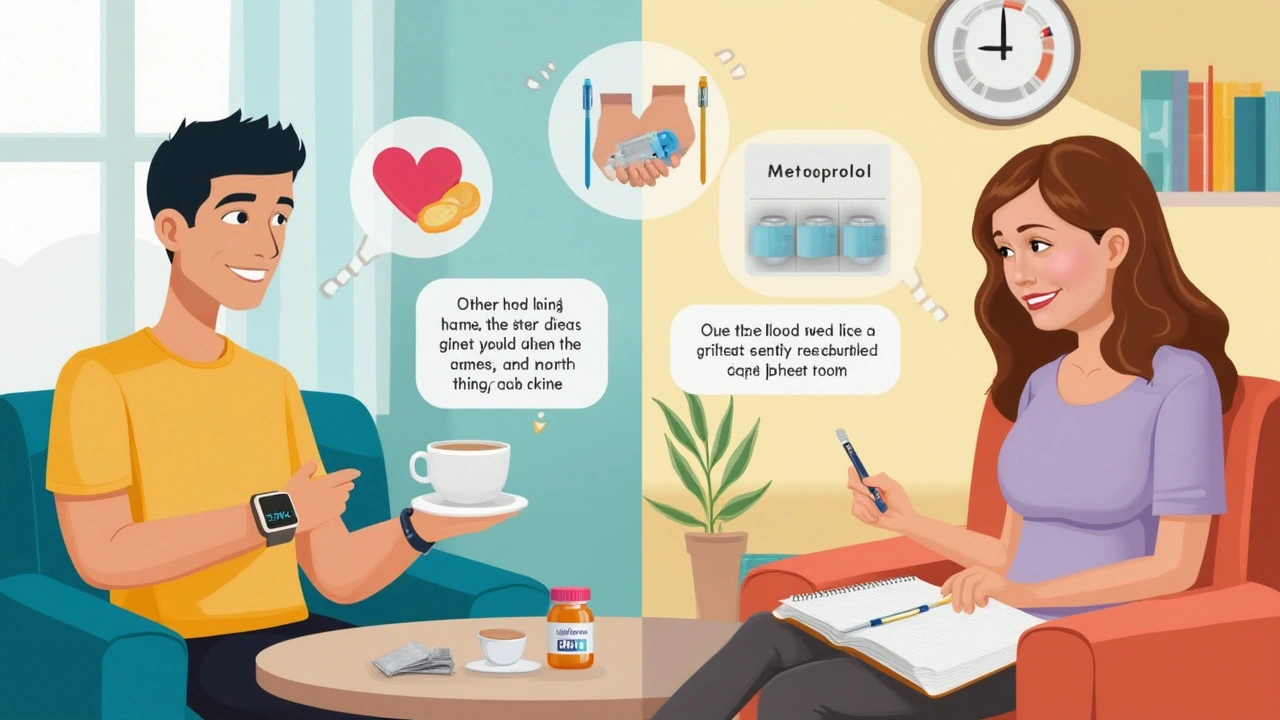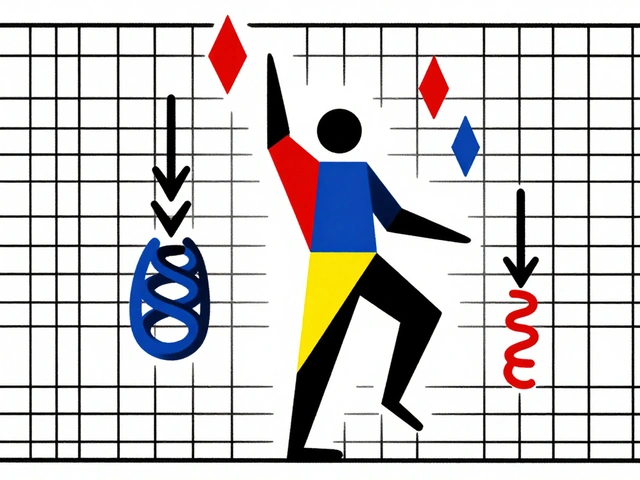How Beta-Blockers Shape Your Heart: Nebivolol vs Metoprolol
If your doctor’s floated the words “beta-blocker” lately, you’ve probably wondered what stands between nebivolol and metoprolol—two heavyweights in heart protection. Both hit the scene to dial down high blood pressure, keep irregular heartbeats in check, and make life a little easier for folks with heart failure or anxiety-driven palpitations. But under the hood, these meds aren’t twins. Their moves on your body—what they slow down, how they drop your blood pressure, and even the side effects—are more different than most people realize.
Nebivolol is what you’d call a newer generation beta-blocker. It doesn’t just block the adrenaline (that’s norepinephrine and epinephrine for us science nerds) from revving up your heart. This one also triggers the body to pump out more nitric oxide, a natural blood vessel relaxer that helps widen your arteries. That little bonus means your blood pressure gets an extra push in the right direction, and your organs are less stressed out during the day. In contrast, metoprolol is more of a classic. It zones in on blocking adrenaline from attaching to beta-1 receptors in your heart, slowing your heart rate and lowering blood pressure the tried-and-true way, but without much impact on those blood vessels directly.
The ripple effects? People often find nebivolol leads to fewer side effects like cold hands, fatigue, or feeling a bit spaced out. Because it only lightly touches the beta-2 receptors that hang out in your lungs and blood vessels, asthma flares are less likely. Metoprolol, meanwhile, works best for folks who don’t have major breathing issues, since it’s a tad less picky about which beta receptors it blocks. If you’re prone to eczema or cold feet, the difference between the two could be huge.
Here’s something interesting: nebivolol is considered more "cardioselective" than metoprolol, especially in low doses. What’s that mean? Basically, it mostly focuses on the heart, not the rest of the body. That makes a difference if you have diabetes or lung conditions since you’re less likely to see blood sugar swings or sudden trouble breathing.
Let’s talk about how quickly these meds get to work. Both nebivolol and metoprolol start lowering blood pressure within a couple of hours after you swallow the pill. But nebivolol hangs around longer in your system—its half-life is around 12 hours, compared to 3 to 7 hours for metoprolol. That translates into once-a-day dosing for nebivolol for most, while metoprolol sometimes needs twice a day unless you get the XL (extended-release) version.
What about real life results? A 2023 analysis from Australia’s own National Heart Foundation pointed out that while both beta-blockers are solid for reducing heart attacks and death in heart failure, nebivolol may edge ahead for tolerability, especially in older folks who need easy, predictable dosing and want to sidestep the usual beta-blocker fatigue.
If you’re curious about how every factor compares—receptor selectivity, half-life, effectiveness in blood pressure, and metabolism—check out this plain-English table:
| Feature | Nebivolol | Metoprolol |
|---|---|---|
| Beta-1 Selectivity | Very High | High |
| Nitric Oxide Release | Yes | No |
| Once-daily Dosing | Yes (5-10 mg/day) | Sometimes (XL only; 50-200 mg/day) |
| Main Use | Hypertension, Heart Failure | Hypertension, Angina, Arrhythmias, Heart Failure |
| Asthma/COPD Friendliness | Better | Not Ideal |
| Common Side Effects | Fatigue, headache (rare) | Fatigue, cold extremities |
| Metabolized By | Liver (CYP2D6) | Liver (CYP2D6) |
| Effect On Blood Sugar | Minimal | May mask hypoglycemia |
Bottom line: both beta-blockers steer your heart and pressure in the right direction—but the journey they take, and what you feel on the ride, often depends on which pill you’re holding.

Dosing Down to Routine: How Nebivolol and Metoprolol Fit Daily Life
The first question off most people’s lips after they get prescribed a beta-blocker is, “When do I take it, and what happens if I forget?” Here’s where the fine print on the pill box actually matters. Nebivolol usually starts with a low dose—5 mg once per day is standard in Australia, with the option to double if blood pressure doesn’t quite hit target. Since it sticks around in your blood longer, missing a dose by a few hours rarely puts you at much risk. That’s a relief for anyone juggling meds or dealing with a busy schedule.
Metoprolol is a bit more old school, unless your script says “extended-release.” Regular metoprolol needs a morning and sometimes an evening dose, depending on your condition. For people with strict routines, this isn’t a problem. But for the sleep-deprived or those running on coffee and chaos, the extended-release version can be a lifesaver. That said, the dose range is much wider. Depending on whether it’s used for blood pressure, heart attacks, or atrial fibrillation, you could see anything from 50 mg to 200 mg per day—or more, if your heart’s stubborn. Doctors usually ramp up the dose every week or so, checking blood pressure and pulse each time to make sure you’re not overdoing it.
There are some neat tricks doctors use to personalize your dosing:
- If you’re over 65, have kidney disease, or are sensitive to dizziness, starting with a lower dose makes sense.
- If you have diabetes, nebivolol’s tendency to leave blood sugar alone gives it an edge.
- Got asthma? Nebivolol’s more selective nature means you’re less likely to get hit with a bronchospasm.
Your body’s own quirks can make a difference, too. Nebivolol is mostly broken down by the CYP2D6 liver enzyme. Some people, especially those of European or Asian descent, process this slower than others, so you might see a stronger effect with a standard dose. Metoprolol uses the same pathway but doesn’t linger as long, so the risk of accidental overdose is less unless you double up doses by mistake.
Around one-third of patients on beta-blockers report feeling fatigue in the first month, according to a 2022 Sydney GP network survey. But if you can tough it out, most of that fades by week three or four. Give your body a little patience—it often finds a groove after the initial chemical shock.
Something a lot of doctors don’t mention: both meds can hide the usual signs of hypoglycemia in diabetics, but nebivolol does this much less. If you check your blood sugar often, you’ll probably notice it drops less with nebivolol than metoprolol, which can blunt all the classic warning signs.
Want to read even deeper about how the details compare? This detailed breakdown of nebivolol vs metoprolol dives into the science—definitely worth checking out if you like to read up before making choices with your cardiologist.
One more handy tip: don’t ever stop a beta-blocker suddenly. Your heart can go into overdrive, raising your risk for heart attack or irregular rhythms. Always cut back slowly and only on your doctor’s advice. People often forget this when they get tired of side effects—it’s worth repeating.

Side Effects, Surprises, and Success Stories: Life on Nebivolol vs Metoprolol
Now for the part everyone dreads—side effects. Sure, both nebivolol and metoprolol aim to be your heart’s bodyguard, but they can still throw a few curveballs your way. Here’s what the day-to-day can look like.
On nebivolol, you’re less likely to turn into a zombie. Fatigue is still a contender, but studies show it’s less common than with metoprolol, especially after the first six weeks. Headaches pop up more in the early weeks but usually fade. Some folks get mild digestive issues, like a bit of queasiness, but it rarely sticks around. The vasodilation (blood vessel opening) effect occasionally drops blood pressure a little too well, leading to occasional light-headedness if you stand up fast. Most people love the bonus that their hands and feet stay warmer on nebivolol compared to metoprolol.
Metoprolol’s main offender is fatigue, often paired with cold extremities. If you’ve ever shaken hands and gotten a weird look because yours feel like an ice block, this could be why. Men sometimes report trouble with sexual function—erectile dysfunction isn’t uncommon, although it tends to improve once bodies adjust to the new medication regimen. Metoprolol also has a history of making vivid dreams or sleep disturbances more common, especially in the first month. Why? No one’s sure, but the theory is that it sneaks into the brain just enough to stir things up. Good news: Many side effects mellow out over time, and a slow dose ramp-up helps tame the worst of them.
Never ignore side effects that seem severe: major dizziness, fainting spells, sudden wheezing, or rapid heart changes need a call to your GP, not just WebMD. Especially if you have asthma or COPD, watch for any worsening breathing trouble, even if you’re on nebivolol, since extreme doses can still tickle those sensitive beta receptors in your lungs.
There’s always a bit of luck in how any one person responds. I’ve heard plenty of Australians swap from one beta-blocker to another and feel like they’re on a new planet—more energy, fewer naps, better exercise tolerance. Others need a different approach entirely, skipping these meds for something like calcium channel blockers if side effects get too rough.
Let’s hit a few practical ideas for thriving with beta-blockers:
- Track your heart rate and blood pressure at home—set reminders to keep a consistent record for your doctor.
- Drink water and get up slowly from bed or the couch to dodge those woozy spells.
- If you’re exercising, start gentle. Both meds slow your top heart rate, so you’ll need to pace yourself at the gym.
- If you notice changes in mood or feel unusually tired for weeks, don’t tough it out alone—adjusting dose or timing can help.
- Keep your scripts refilled ahead of time—missing several days can give your heart withdrawal symptoms.
One last fact worth mentioning: nebivolol is still a bit pricier in Australia compared to metoprolol, and not all insurance plans cover it as easily. But for certain health profiles—older age, frequent cold hands, or asthma—a conversation with your doctor about the long-term payoff is absolutely worth it. At the end of the day, the "best" beta-blocker helps you hit your heart rate and blood pressure goals with the fewest side effects, and that can sometimes mean trial and error.
Wading through heart medication options feels overwhelming at first, but armed with facts, real-world tips, and a few good questions for your doctor, you can pick the beta-blocker that fits your heart and your life. Whether nebivolol or metoprolol winds up in your medicine cabinet, remember: results come from the right match, not the flashiest new pill.






Keiber Marquez
May 4, 2025 AT 15:17America needs stronger hearts, not these wimpy meds.
Lily Saeli
May 8, 2025 AT 02:37We must consider the ethical weight of prescribing a drug that may alter our very sensations. To ignore the subtle ways nebivolol or metoprolol influence daily life is to treat patients like experiments. Every choice carries a moral responsibility to minimize fatigue and preserve dignity. The article serves as a reminder that medicine is not just chemistry, but a covenant with the human spirit.
Joshua Brown
May 11, 2025 AT 13:57When comparing nebivolol and metoprolol, start by looking at receptor selectivity, which determines how each drug interacts with beta-1 versus beta-2 receptors, and consequently, side‑effect profiles. Next, consider half‑life: nebivolol’s roughly 12‑hour half‑life allows once‑daily dosing, while metoprolol’s 3‑7‑hour half‑life often requires twice‑daily administration or an extended‑release formulation. Also, assess nitric‑oxide release-unique to nebivolol, it provides vasodilation that can improve peripheral circulation. Finally, evaluate patient‑specific factors such as asthma, diabetes, and age, because these comorbidities influence which beta‑blocker will be better tolerated.
andrew bigdick
May 15, 2025 AT 01:17Good breakdown, man! I’d add that checking the patient’s CYP2D6 genotype can be a game‑changer, especially for those who metabolize these drugs slower and feel extra fatigue.
Shelby Wright
May 18, 2025 AT 12:37Oh wow, reading this feels like stepping into a soap opera of pills! Nebivolol waltzes in with its fancy nitric‑oxide sparkle, promising warm hands and a breezy heartbeat, while Metoprolol slams the door with an old‑school grip, demanding you accept cold extremities as a rite of passage. The drama intensifies when side effects rear their ugly heads-fatigue, headaches, even those bizarre vivid dreams that make you question reality. And let’s not forget the price tag showdown; nebivolol’s cost can sting like a plot twist you didn’t see coming. Bottom line: pick your protagonist wisely, because the sequel could be your health.
Ellen Laird
May 21, 2025 AT 23:57Ths medcine cant be taken wihout a doconsult.
rafaat pronoy
May 25, 2025 AT 11:17Pretty solid rundown, especially the part about once‑daily dosing 😊. Helps keep the schedule simple for busy folks.
sachin shinde
May 28, 2025 AT 22:37The preceding paragraph suffers from hyperbole and lacks empirical substantiation; assertions such as "nebivolol waltzes in" are colloquial absurdities that undermine scientific credibility. Moreover, the mention of "price tag showdown" is anecdotal and requires citation. A revised exposition should prioritize data‑driven statements over theatrical flourish.
Leon Wood
June 1, 2025 AT 09:57Great guide! I feel more confident about discussing options with my cardiologist now. The clarity on dosing schedules is especially helpful.
George Embaid
June 4, 2025 AT 21:17Happy to hear that! Remember to keep a log of your blood pressure and heart rate; those numbers can guide fine‑tuning your therapy.
Meg Mackenzie
June 8, 2025 AT 08:37Some folks think the pharma giants push metoprolol because it’s cheaper to produce, keeping profits high while sidelining the newer nebivolol. It’s not just about chemistry; there’s a whole network of lobbying that shapes which drug ends up on the shelf. Trust but verify, and always ask your doctor about the underlying incentives.
Shivaraj Karigoudar
June 11, 2025 AT 19:58When one delves into the pharmacodynamic nuances of beta‑adrenergic antagonism, it becomes evident that nebivolol’s unique mechanism-namely its capacity to stimulate endothelial nitric‑oxide synthase-introduces a vasodilatory dimension absent in conventional beta‑blockers such as metoprolol. This endothelial interaction not only ameliorates peripheral vascular resistance but also modulates shear‑stress‑induced signaling pathways, thereby exerting a secondary antihypertensive effect that is pharmacologically distinct. Moreover, the pharmacokinetic profile of nebivolol, characterized by a half‑life approximating twelve hours, facilitates once‑daily administration, which aligns with adherence‑optimizing strategies espoused in contemporary therapeutic guidelines. In contrast, metoprolol’s relatively shorter half‑life, ranging from three to seven hours, necessitates either twice‑daily dosing or reliance on extended‑release formulations to achieve comparable plasma steadiness. The metabolic fate of both agents converges on the CYP2D6 isoenzyme, yet polymorphic variations within this pathway engender interindividual discrepancies in drug clearance, rendering genotype‑guided dosing an emerging frontier. Clinical trials, such as the 2023 Australian National Heart Foundation analysis, have illuminated nebivolol’s superior tolerability profile, particularly among geriatric cohorts where fatigue and cold extremities precipitate discontinuation of therapy. Nevertheless, one must not discount metoprolol’s entrenched efficacy in post‑myocardial infarction management and arrhythmia suppression, where its beta‑1 selectivity has been corroborated across multiple randomized controlled studies. Economic considerations further complicate the decision matrix; nebivolol’s premium pricing may pose barriers within publicly funded health systems, whereas metoprolol’s generic availability ensures broader accessibility. Patient‑centred care mandates a holistic appraisal that incorporates comorbidities such as asthma, diabetes, and renal insufficiency, each of which modulates the risk‑benefit calculus. For example, nebivolol’s relative beta‑2 sparing effect mitigates bronchospastic risk, an attribute of paramount importance in asthmatic individuals. Conversely, metoprolol’s propensity to obscure hypoglycemic symptoms mandates vigilant glucose monitoring in diabetic patients. Ultimately, the therapeutic selection should be anchored in a shared decision‑making paradigm, wherein clinicians elucidate the mechanistic divergences, dosing logistics, side‑effect spectra, and fiscal implications, empowering patients to make informed choices aligned with their lifestyle and health priorities. As the field advances, ongoing pharmacogenomic research may further delineate subpopulations that derive maximal benefit from one agent over the other, heralding an era of precision beta‑blockade.
Matt Miller
June 15, 2025 AT 07:18Solid summary, thanks.
Fabio Max
June 18, 2025 AT 18:38The article nails the key differences, especially the nitric‑oxide boost from nebivolol. I appreciate the practical dosing tips that make it easier to fit into daily routines. Also, the side‑effect comparison helps set realistic expectations. Overall, a very balanced guide.
Darrell Wardsteele
June 22, 2025 AT 05:58While the piece is generally ok it contains numerous grammatical slips; such errors reflect sloppy editing and undermine credibility. Moreover, the author fails to address the broader impact of cardiovascular health on national productivity, a glaring omission.
Madeline Leech
June 25, 2025 AT 17:18Honestly, if you’re not looking at the big picture of how heart health fuels our nation’s strength, you’re missing the point. These meds aren’t just pills-they’re tools that keep our workforce robust. Choose wisely.
Barry White Jr
June 29, 2025 AT 04:38Good read thanks
Andrea Rivarola
July 2, 2025 AT 15:58Reading through the guide, I found myself reflecting on how each pharmacologic nuance subtly reshapes day‑to‑day living. The distinction between nebivolol’s nitric‑oxide mediated vasodilation and metoprolol’s pure beta‑1 blockade is more than academic; it translates into palpable differences in peripheral warmth and exercise tolerance. While the author touches on these aspects, a deeper dive into patient‑reported outcomes could enrich the narrative. Additionally, the discussion of CYP2D6 polymorphisms hints at personalized medicine, yet practical guidance for clinicians remains sparse. From a grammatical standpoint, the article maintains consistency, though occasional redundancies could be trimmed for conciseness. As someone who prefers measured pacing, I appreciate the balanced tone that avoids sensationalism. The inclusion of practical tips-like gradual dose titration and monitoring strategies-enhances its utility for both patients and providers. In sum, the piece succeeds in demystifying a complex topic while leaving room for further elaboration.
Tristan Francis
July 6, 2025 AT 03:18They don’t tell you that big pharma pushes metoprolol because it’s cheaper for them. The real story is hidden.
Keelan Walker
July 9, 2025 AT 14:38Wow this guide really breaks down the whole nebivolol vs metoprolol debate 😊 It’s cool how they explain the nitric oxide thing and how that helps keep vessels relaxed 😌 The dosing info is super helpful especially for those of us who forget our meds sometimes 😅 Also the side effect section gives a real picture – no more guessing if your hands will be cold or not 👍 And the bit about asthma compatibility is a lifesaver for people with breathing issues 🫁 Overall this post makes the whole beta blocker thing less scary and more understandable 🙌 Thanks for the clear tables and the practical tips 💡